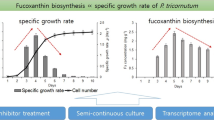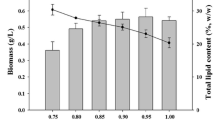Abstract
Fucoxanthin is a carotenoid that exerts multiple beneficial effects on human health. However, reports comparing microalgae culture conditions and their effect on growth and fucoxanthin production are still limited. Isochrysis galbana and Phaeodactylum tricornutum cultures in different light (62.0, 25.9, 13.5, or 9.1 μmol photons m-2 s-1), mixing conditions (1 vvm aeration or 130 rpm agitation), and media compositions (F/2 and Conway medium) were studied for comparison of cellular growth and fucoxanthin production on F/2 medium. I. galbana showed a better adaptation to tested culture conditions in comparison with P. tricornutum, reaching 2.15 × 107 ± 4.07 × 106 cells mL-1 and a specific growth rate (μ) of 1.12 ± 0.05 day-1 under aerated conditions and 62.0 μmol photons m-2 s-1 light intensity. Fucoxanthin concentration was about 25 % higher in P. tricornutum cultures under 13.5 μmol photons m-2 s-1 light intensity and aerated conditions, but the highest fucoxanthin total production was higher in I. galbana, where 3.32 mg can be obtained from 1 L batch cultures at the 16th day under these conditions. Moreover, higher cell densities (~32.41 %), fucoxanthin concentration (~42.46 %), and total production (~50.68 %) were observed in I. galbana cultures grown in Conway medium, if compared with cultures grown in F/2 medium. The results show that the best growth conditions did not result in the best fucoxanthin production for either microalgae, implying that there is not a direct relationship between cellular growth and fucoxanthin production. Moreover, the results suggest that I. galbana cultures on Conway medium are strong candidates for fucoxanthin production, where 1.2 to 15 times higher fucoxanthin concentration are observed in comparison to macroalgal sources.






Similar content being viewed by others
References
Alkhamis Y, Qin JG (2013) Cultivation of Isochrysis galbana in phototrophic, heterotrophic, and mixotrophic conditions. Biomed Res Int 2013:983465
Boczar BA, Prezelin BB (1989) Organization and comparison of chlorophyll-protein complexes from two fucoxanthin-containing algae: Nitzschia closterium (Bacillariophyceae) and Isochrysis galbana (Prymnesiophyceae). Plant Cell Physiol 30:1047–1056
Brindley Alías C, García-Malea López MC, Acién Fernández FG, Fernández Sevilla JM, García Sánchez JL, Molina Grima E (2004) Influence of power supply in the feasibility of Phaeodactylum tricornutum cultures. Biotechnol Bioeng 87:723–733
Büchs J, Maier U, Milbradt C, Zoels B (2000) Power consumption in shaking flasks on rotary shaking machines: I. Power consumption measurement in unbaffled flasks at low liquid viscosity. Biotechnol Bioeng 68:589–593
Carreto JI, Catoggio JA (1976) Variations in pigment contents if the diatom Phaeodactylum tricornutum during growth. Mar Biol 36:105–112
Carvalho AP, Meireles LA, Malcata FX (2006) Microalgal reactors: a review of enclosed system designs and performances. Biotechnol Prog 22:1490–1506
Christenson L, Sims R (2011) Production and harvesting of microalgae for wastewater treatment, biofuels, and bioproducts. Biotechnol Adv 29:686–702
Chung TW, Choi HJ, Lee JY, Jeong HS, Kim CH, Joo M, Choi JY et al (2013) Marine algal fucoxanthin inhibits the metastatic potential of cancer cells. Biochem Biophys Res Commun 439:580–585
Clark DR, Merrett MJ, Flynn KJ (1999) Utilization of dissolved inorganic carbon (DIC) and the response of the marine flagellate Isochrysis galbana to carbon or nitrogen stress. New Phytol 144:463–470
D’Orazio N, Gemello E, Gammone MA, De Girolamo M, Ficoneri C, Riccioni G (2012) Fucoxanthin: a treasure from the sea. Mar Drugs 10:604–616
Durmaz Y, Donato M, Monteiro M, Gouveia L, Nunes ML, Gama Pereira T, Gokpinar S, Bandarra NM (2008) Effect of temperature on growth and biochemical composition (sterols a-tocopherol, carotenoids, fatty acid profiles) of the microalga, Isochrysis galbana. Isr J Aquacult 60:190–197
Gómez-Loredo A, Benavides J, Rito-Palomares M (2014a) Partition behavior of fucoxanthin in ethanol-potassium phosphate two-phase systems. J Chem Technol Biotechnol 89:1637–1645
Gómez-Loredo A, González-Valdez, Rito-Palomares M (2014b) Insights on the downstream purification of fucoxanthin, a microalgal carotenoid, from an aqueous two-phase system stream exploiting ultrafiltration. J Appl Phycol. doi:10.1007/s10811-014-0443-y
Guermazi W, Masmoudi S, Boukhris S, Ayadi H, Morant-Manceau A (2014) Under low irradiation, the light regime modifies growth and metabolite production in various species of microalgae. J Appl Phycol 26:2283–2293
Guillard RRL (1975) Culture of phytoplankton for feeding marine invertebrates. In: Smith WL, Chanley MH (eds) Culture of marine invertebrate animals. Plenum Press, New York, pp 26–60
Guillard RRL, Ryther JH (1962) Studies of marine planktonic diatoms. I. Cyclotella nana Hustedt and Detonula confervacea (Cleve). Can J Microbiol 8:229–239
Jin E, Polle JEW, Lee HK, Hyun SM, Chang M (2003) Xanthophylls in microalgae: from biosynthesis to biotechnological mass production and application. J Microbiol Biotechnol 13:165–174
Kaixian Q, Borowitzka MA (1993) Light and nitrogen deficiency effects on the growth and composition of Phaeodactylum tricornutum. Appl Biochem Biotechnol 38:93–103
Kim SM, Jung YJ, Kwon ON, Cha KH, Um BH, Chung D, Pan CH (2012a) A potential commercial source of fucoxanthin extracted from the microalga Phaeodactylum tricornutum. Appl Biochem Biotechnol 166:1843–1855
Kim SM, Kang SW, Kwon ON, Chung D, Pan CH (2012b) Fucoxanthin as a major carotenoid in Isochrysis aff. galbana: characterization of extraction for commercial application. J Korean Soc Appl Biol Chem 55:477–483
Klein B (1988) Variations of pigment content in two benthic diatoms during growth in batch cultures. J Exp Mar Biol Ecol 115:237–248
Lananan F, Jusoh A, Ali N, Lam SS, Endut A (2013) Effect of Conway medium and f/2 medium on the growth of six genera of South China Sea marine microalgae. Bioresour Technol 141:75–82
Lavaud J, Rousseau B, Etienne AL (2003) Enrichment of the light-harvesting complex in diadinoxanthin and implications for the nonphotochemical fluorescence quenching in diatoms. Biochemistry 42:5802–5808
Mata TM, Martins AA, Caetano NS (2010) Microalgae for biodiesel production and other applications: a review. Renew Sust Energ Rev 14:271–232
Miyashita K, Nishikawa S, Beppu F, Tsukui T, Abe M, Hosokawa M (2011) The allenic carotenoid fucoxanthin, a novel marine nutraceutical from brown seaweeds. J Sci Food Agric 91:1166–1174
Molina Grima E, Sánchez Pérez JA, García Sánchez JL, García Camacho F, López Alonso D (1992) EPA from Isochrysis galbana. Growth conditions and productivity. Process Biochem 27:299–305
Mulders KJM, Lamers PP, Martens DE, Wijffels RH (2014) Phototrophic pigment production with microalgae: biological constraints and opportunities. J Phycol 50:229–242
Murray PM, Moane S, Collins C, Beletskaya T, Thomas OP, Duarte AWF, Nobre FS et al (2013) Sustainable production of biologically active molecules of marine based origin. Nat Biotechnol 30:839–850
Nymark M, Valle KC, Brembu T, Hancke K, Winge P, Andresen K, Johnsen G, Bones AM (2009) An integrated analysis of molecular acclimation to high light in the marine diatom Phaeodactylum tricornutum. PLoS One 4, e7743
Peng X, Liu S, Zhang W, Zhao Y, Chen L, Wang H, Liu T (2014) Triacylglycerol accumulation of Phaeodactylum tricornutum with different supply of inorganic carbon. J Appl Phycol 26:131–139
Reddy CRK, Jha B, Fujita Y, Ohno M (2008) Seaweed micropropagation techniques and their potentials: an overview. J Appl Phycol 20:609–617
Rosello Sastre R, Csögör Z, Perner-Nochta I, Fleck-Schneider P, Posten C (2007) Scale-down of microalgae cultivations in tubular photo-bioreactors—A conceptual approach. J Biotechnol 132:127–133
Sánchez Mirón A, Cerón García MC, García Camacho F, Molina Grima E, Chisti Y (2002) Growth and biochemical characterization of microalgal biomass produced in bubble column and airlift photobioreactors: studies in fed-batch culture. Enzym Microb Technol 31:1015–1023
Sun Y, Wang C (2009) The optimal growth conditions for the biomass production of Isochrysis galbana and the effects that phosphorus, Zn2+, CO2, and light intensity have on the biochemical composition of Isochrysis galbana and the activity of extracellular CA. Biotechnol Bioprocess Eng 14:225–231
Sutherland DL, Howard-Williams C, Turnbull MH, Broady PA, Craggs RJ (2015) The effects of CO2 addition along a pH gradient on wastewater microalgal photo-physiology, biomass production and nutrient removal. Water Res 70:9–26
Suzuki R, Takahashi M, Furuya K, Ishimaru T (1993) Simplified technique for the rapid determination of phytoplankton pigments by reverse-phase high-performance liquid chromatography. J Oceanogr 49:571–580
Torzillo G, Pushparaj B, Masojidek J, Vonshak A (2003) Biological constraints in algal biotechnology. Biotechnol Bioprocess Eng 8:338–348
Walker TL, Purton S, Becker DK, Collet C (2005) Microalgae as bioreactors. Plant Cell Rep 24:629–641
Walne PR (1970) Studies on food value of nineteen genera of algae to juvenile bivalves of the genera Ostrea, Crassostrea, Mercenaria and Mytilus. Fish Invest Lond Ser 2 26:1–62
Xia S, Wang K, Wan L, Li A, Hu Q, Zhang C (2013) Production, characterization, and antioxidant activity of fucoxanthin from the marine diatom Odontella aurita. Mar Drugs 11:2667–2681
Acknowledgments
The authors would like to thank the financial support of Consejo Nacional de Ciencia y Tecnología (CONACyT, Grant 333554), the ITESM Research Chair (Grant CAT020), the Bioprocess and Synthetic Biology Strategic Focus Group of Tecnológico de Monterrey (0821C01004), and the Zambrano-Hellion Fund (CDB090).
Author information
Authors and Affiliations
Corresponding author
Rights and permissions
About this article
Cite this article
Gómez-Loredo, A., Benavides, J. & Rito-Palomares, M. Growth kinetics and fucoxanthin production of Phaeodactylum tricornutum and Isochrysis galbana cultures at different light and agitation conditions. J Appl Phycol 28, 849–860 (2016). https://doi.org/10.1007/s10811-015-0635-0
Received:
Revised:
Accepted:
Published:
Issue Date:
DOI: https://doi.org/10.1007/s10811-015-0635-0




